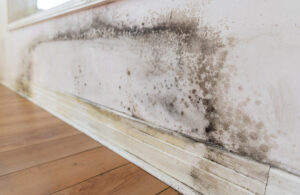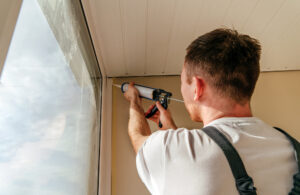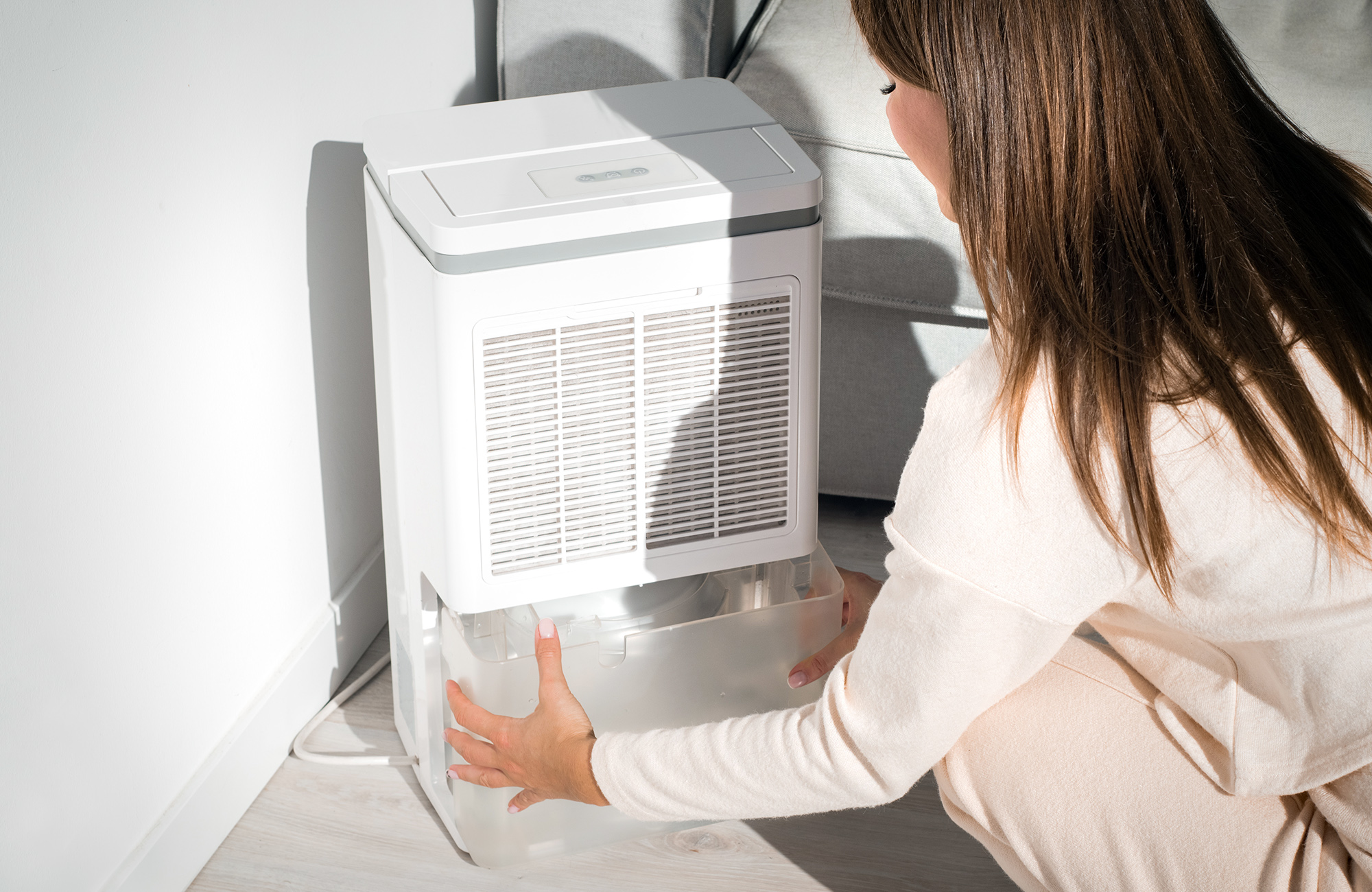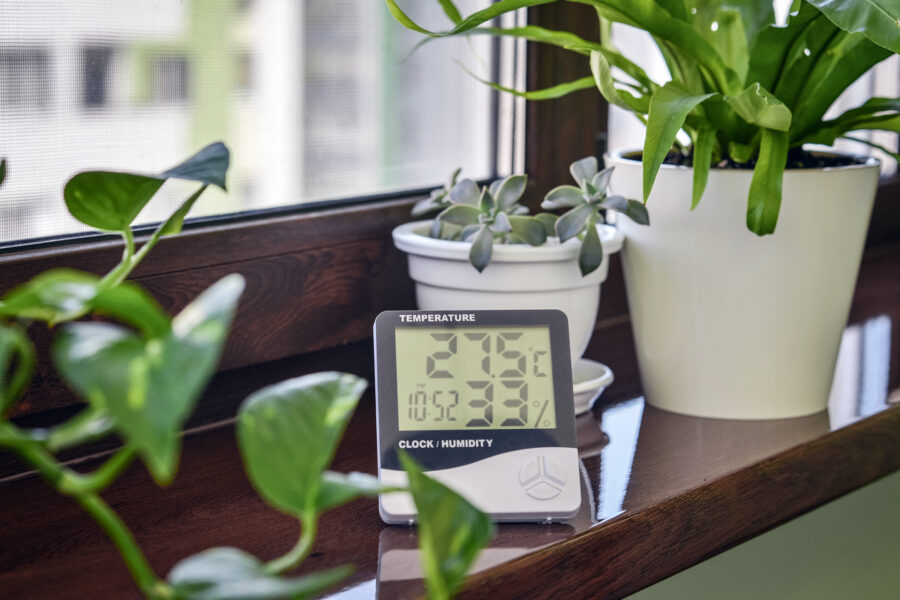For the comfort of its occupants, it pays to know how to lower humidity in a house. High humidity can be a source of skin irritation because it encourages mold growth. Plus, too much moisture in the air can hinder cooling.
How to Lower Humidity in House
High humidity not only deters cooling in a home but also promotes the growth of mold and mildew. Mold and mildew can have adverse effects on a person’s health, especially if that person is allergic. Furthermore, humidity can cause structural damage by encouraging the build-up of moisture.
Given the negative impact of high humidity, it is important to take action before things worsen. Here is how to decrease humidity in a house.
1. Use a Dehumidifier
Purchasing a dehumidifier is a great investment for high humidity levels. Dehumidifiers remove excess moisture from the air, so it tackles the problem from the source. There are several kinds of dehumidifiers, even portable ones that a homeowner can place in their basement.
 2. Run the Air Conditioner
2. Run the Air Conditioner
How to lower humidity in house? Air conditioners are natural dehumidifiers, as they cool the air and remove excess moisture. Homeowners should make sure that their air conditioners are working properly. This way, they can effectively regulate indoor humidity levels.
3. Utilize Exhaust Fans
Exhaust fans are another way to remove excess moisture from the air. Installing exhaust fans in bathrooms and kitchens can make these spaces more comfortable. Make sure to leave them on for 15 minutes after a shower or cooking.
4. Increase Air Circulation
Air circulation is key to dehumidifying a space. Homeowners should purchase ceiling fans and box fans to promote air circulation. Keeping windows open can also prevent humid air from building up inside the house.
5. Reduce Indoor Water Sources
More often than not, indoor activities that involve water can contribute to high humidity levels. Good examples of these include drying clothes indoors, leaving stagnant water to pool in sinks or tubs, and even overwatering plants. Limiting these activities can prevent moisture from accumulating in a closed space.
6. Use Moisture-Absorbing Materials
Cabinets and closets can also suffer from excess moisture, especially since these spaces are closed. Humidity in these places can damage the furniture and the clothes inside. Silica gel, rock salt, and activated charcoal are all desiccants, which means placing them in these spaces can absorb moisture.
7. Adjust the Thermostat
How to lower humidity in house? Homeowners should keep their thermostats at an appropriate temperature, which is somewhere between 72°F to 78°F. This should help reduce moisture from the enclosed space.
Why is my House so Humid?
It is one thing to learn how to reduce humidity in house, but it is equally important to learn the cause of humidity in the first place. Here are the causes of high humidity in a home.
 1. Everyday Activities
1. Everyday Activities
Some people might not know it, but simply doing everyday things can cause moisture to accumulate in a home. Activities such as cooking, showering, and drying clothes indoors can release moisture into the air. Without proper ventilation, these activities can contribute to higher humidity levels.
2. Poor Ventilation
Proper airflow is a major factor in reducing humidity in a home. Homeowners should invest in exhaust fans in enclosed spaces such as bathrooms and kitchens. They should also purchase dehumidifiers for basements and keep windows open in larger areas.
 3. Leaks and Water Intrusion
3. Leaks and Water Intrusion
Leaks in roofs, pipes, or foundations can introduce excess moisture into a home. Over time, this can lead to mold growth, structural issues, and an overall increase in humidity levels.
4. High Outdoor Humidity
In humid climates, outdoor moisture can seep into homes through cracks, windows, and doors. If the air conditioning system is not functioning properly, it may find it hard to remove excess moisture within the house.
5. HVAC System Issues
A good air conditioner can help remove excess moisture in a home. Homeowners should check their AC to see if it is a proper size and working properly. Both these factors can affect efficient humidity regulation.
How to Prevent High Humidity in the House
Prevention is always better than a cure. Now that owners know how to lower humidity in house, they should take the necessary steps to keep humidity levels from rising in the first place. Here are the ways to prevent high humidity.
1. Improve Ventilation
Keep moisture from building up inside the home by ensuring proper ventilation. Homeowners can improve airflow and enjoy the fresh air at the same time by installing exhaust fans and opening windows.
 2. Seal Leaks and Cracks
2. Seal Leaks and Cracks
To prevent water intrusion and damage, homeowners should inspect for leaks regularly. If found, these leaks and cracks should be repaired and sealed to keep humidity outside.
3. Use Humidity-Resistant Materials
For new homes, it is a good idea to use humidity-resistant materials such as mold-resistant drywall and water-resistant paints. The same applies to renovations.
4. Maintain HVAC System
Homeowners should stick to a maintenance schedule for their HVAC systems. Regular service can ensure functionality and allow air conditioners to reduce humidity effectively.
5. Keep Indoor Plants in Check
While houseplants can improve indoor air quality, having too many of them can contribute to excess moisture. Homeowners should consider removing a few houseplants if they start to notice high humidity levels in an otherwise well-ventilated area.
What Causes High Humidity in a House in Winter?
Humidity is a huge issue in the summer months, but wintertime can also bring problems with moisture levels. Here are the most common causes of house humidity in winter.
1. Sealed Homes for Energy Efficiency
During winter, homes are often sealed tightly to keep heat inside. Although this improves energy efficiency, it also traps moisture. Moisture then has a hard time escaping, leading to high humidity levels.
2. Indoor Heating Systems
Some types of heating systems don’t regulate humidity effectively. These include radiant heating or space heaters. As a result, excess moisture can accumulate.
3. Poor Ventilation
As with any time of the year, poor ventilation in winter can contribute to high humidity. Homeowners usually keep their windows and doors closed during colder months, preventing moisture from escaping as they go on with their daily activities.
 4. Snow and Ice Melting
4. Snow and Ice Melting
When snow and ice melt, moisture can find its way into the home, especially near the doors, windows, and foundations. This cycle can then make humidity levels higher in houses during the winter.
How to Lower Humidity in House in Winter
Winter is not always associated with high humidity in house. This is why, when it happens, homeowners don’t usually know what to do. Fortunately, they can use the same tips as any other season to reduce humidity levels.
Homeowners can use a dehumidifier, adjust their thermostat, and use exhaust fans to get rid of excess moisture and improve airflow. Due to the cold weather, it may not be smart to keep their windows open, but opening them periodically – when possible – can also help. Beyond that, homeowners should invest in better insulation, both for the winter temperature and to prevent the buildup of condensation, which contributes to humidity.
How to Lower Humidity in House: Answered!
High humidity levels can mess with a homeowner’s health and comfort. It can also cause damage to the walls, paint, and structure of the home. Given the consequences of keeping humidity levels unchecked, it is best to regulate humidity and prevent it from spiking. If it does go up, homeowners are now equipped with the knowledge to bring it back down.
Hillcrest provides expert HOA management services in Chicago and its suburbs. Call us today at 630-627-3303 or contact us online to request a proposal!




